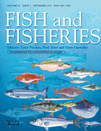Squaring the circle?
It may be that reconciling the goals of conservation and greater yields is less difficult than was previously thought.
Main content
At least, that is what BIO Associate Professor, Jeppe Kolding, and colleagues argue in their “Ghoti” paper: “Squaring the circle: reconciling fishing and conservation of aquatic ecosystems”.
They argue that balanced harvesting
- Helps retain the demographic power-law size-structure of natural ecosystems
- Is less likely to destabilize aquatic communities
- Can cause substantial increases in overall biomass yield
The article takes the discussion into the realm of mathematics and modelling to compare harvesting by balanced harvesting or minimum-size regulations. Read more.
While the authors conclude that it may not be as difficult as might have been expected to reconcile fishing and conservation, it will, however, require fundamental changes in how fishing takes place.
Kolding brings these results to his work in the EAF-Nansen project, which aims to be involved in “Strengthening the Knowledge Base for and implementing an Ecosystem Approach to Marine Fisheries in Developing Countries”. Kolding is a member of the Capacity Development team in this project.
Background information:
"Ghoti papers
Ghoti aims to serve as a forum for stimulating and pertinent ideas. Ghoti publishes succinct commentary and opinion that addresses important areas in fish and fisheries science. Ghoti contributions will be innovative and have a perspective that may lead to fresh and productive insight of concepts, issues and research agendas. All Ghoti contributions will be selected by the editors and peer reviewed.
Etymology of Ghoti
George Bernard Shaw (1856–1950), polymath, playwright, Nobel prize winner, and the most prolific letter writer in history, was an advocate of English spelling reform. He was reportedly fond of pointing out its absurdities by proving that ‘fish’ could be spelt ‘ghoti’. That is: ‘gh’ as in ‘rough’, ‘o’ as in ‘women’ and ‘ti’ as in palatial." (from Fish and Fisheries)
Dynamic, size-spectrum models
Flows in a dynamic, size-spectrum model keeps internal account of all biomass through the density of organisms of a range of body sizes over time. Through feeding on smaller organisms, there is an increase in body size of the predator and a decrease of the prey. Such changes to density potentially occur at all body sizes except for the largest, which dies of senescence, and the smallest, where renewal occurs through reproduction from the adults. Food for the smallest organisms in the dynamic spectrum is provided by a fixed plankton spectrum.

